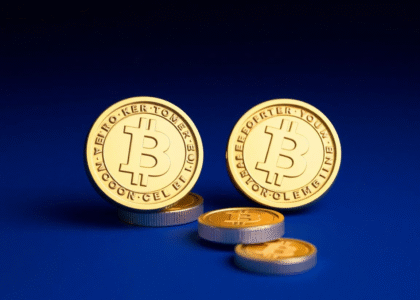The old-school trading floor, with its shouting brokers and frantic hand gestures, is giving way to an increasingly digital landscape. Digital coins, blockchain technology, and a realm called tokenomics have taken center stage, potentially upending the financial market as we know it.
Tokenomics 101: A Crash Course
Coined from “token” and “economics,” tokenomics is the science behind the creation, distribution, and management of digital tokens. Imagine having a virtual penny that can be traded, sold, or held onto for dear life – that’s a digital token in a nutshell. Tokenomics, the rules of the game, guide how these tokens are created, how they move, and how they’re stored.
A New Player in the Crypto Game
Where does tokenomics fit into the wider universe of blockchain networks? It’s the backbone, providing the stability, security, and sustainability needed to keep these networks humming along. Through effective tokenomics, blockchain projects can motivate miners, validators, and users to participate and maintain the network, in addition to managing token supply and demand [1].
Making Waves: How Tokenomics Challenges the Status Quo
1. A New Dawn for Finance
One of the most radical shifts tokenomics brings is the democratization of financial services. Picture this: instead of having to go through banks or brokers, users can lend, borrow, and trade using decentralized finance (DeFi) platforms. It’s akin to having a stock exchange in your pocket. This shift has led to the rise of decentralized exchanges (DEXs), where tokenomics is the conductor orchestrating peer-to-peer trading of digital assets.
2. Expanding the Asset Universe
Tokenomics has been a fertile ground for novel asset classes and investment opportunities. Digital tokens can be a stand-in for anything from cryptocurrencies to tokenized real-world assets like stocks, real estate, and commodities. It’s like opening a door to new investment avenues, offering ways to diversify portfolios and tap into assets that were previously hard to reach.
3. Boosting Liquidity and Market Efficiency
Tokenomics is also instrumental in ramping up liquidity and market efficiency. The secret sauce here is automated market makers (AMMs) – a key feature in DeFi. By pooling tokens, AMMs form liquidity pools, doing away with the need for traditional order books and thus reducing spreads and slippage.
Facing the Music: Criticisms and Challenges
1. The Regulatory Tightrope
Tokenomics hasn’t escaped the watchful eyes of regulators. Initial coin offerings (ICOs), token sales, and the classification of tokens as securities have raised regulatory eyebrows. Agencies like the U.S. Securities and Exchange Commission (SEC) have started to impose stricter guidelines and crackdown on non-compliant projects.
2. Volatility and Market Manipulation
Despite its benefits, tokenomics can be a double-edged sword, contributing to market manipulation and volatility. Poorly designed token models and pump-and-dump schemes are a case in point, fueling calls for robust token design principles and greater transparency.
Looking Ahead: The Future of Tokenomics
1. Merging Lanes: Traditional and Decentralized Finance
As tokenomics redefines trading, we’re likely to see traditional and decentralized finance converge. This could foster greater collaboration between traditional financial institutions and blockchain projects, and weave tokenomics into the fabric of existing financial systems.
2. Innovative Token Design
The future of tokenomics is poised to witness innovative token designs as blockchain projects seek to improve their economic models and mitigate the criticisms and challenges outlined above. This might involve the creation of more sophisticated token models that enhance stability, promote long-term growth, and combat market manipulation and volatility [1].
[1] https://www.forbes.com/sites/rogerhuang/2020/02/25/pump-and-dump-schemes-undermine-cryptocurrencies
3. Regulatory Evolution
As tokenomics grows and evolves, so too will regulatory frameworks. The challenge for regulators will be to strike a balance between investor protection and innovation fostering. This could mean crafting new regulatory blueprints that can accommodate the distinct attributes of digital tokens and their underlying economic systems.
4. Mainstream Adoption of Tokenized Assets
The future could see tokenized assets becoming a regular part of our financial diet. As more individuals and institutions wake up to the potential benefits of trading and investing in digital tokens, traditional trading markets may be further disrupted. Tokenized assets could become a significant portion of global financial markets.
Conclusion: A Brave New World
The emergence of tokenomics marks the dawn of a potentially transformative era in the financial markets. By democratizing finance, creating new asset classes and investment opportunities, and improving liquidity and market efficiency, tokenomics is helping to redraw the financial landscape.
While there are still hurdles to overcome and criticisms to address, the future of tokenomics holds a promise of continued innovation and the potential for mainstream adoption of tokenized assets. As we look to this future, it’s clear that the financial market as we know it might just be on the brink of a seismic shift.
FAQs
What is “tokenomics”?
Ah, good one! Tokenomics merges “token” and “economics”. It’s the study of how tokens work within the broader crypto ecosystem. Think of it like the DNA of a cryptocurrency.
How does tokenomics impact trading?
Well, pal, tokenomics dictates token supply, distribution, and utility. This can majorly sway trader sentiment and drive price moves. Strong tokenomics = bullish vibes!
Are all tokenomics models the same?
Nope! Just like snowflakes, each project has its own unique tokenomics. Some might focus on staking rewards, while others push for transaction burns. Diversity is key in the cryptoverse!
What’s this “burning” everyone talks about?
Heard of Burning Man? Jokes aside, burning’s about permanently removing tokens from circulation. Helps in scarcity and usually gives prices a little moonshot!
How do tokenomics affect liquidity?
Great Q! Projects with tokenomics that incentivize holding or staking can lead to reduced liquidity. It’s like telling traders, “Hold on tight; it’s gonna be a wild ride!”
What are “vesting periods” in tokenomics?
Ah, vesting! It’s like a crypto time-lock. Projects use it to gradually release tokens over time, usually to team members. Stops them from dumping all at once. Smart, right?
I’ve heard of “reflection” in tokenomics. What’s that?
Reflection is the new black! It’s where holders get more tokens just by holding. A fraction of every transaction gets redistributed to holders. Passive gains, baby!
Does strong tokenomics mean guaranteed success?
Wish it were that simple! Strong tokenomics is a plus, but you’ve also gotta consider tech, community, use-case… and a sprinkle of moon magic (or market sentiment)!
What about “rug pulls”?
Ouch! A “rug pull” is when dodgy developers bail with the funds. Tokenomics can be flashy to mask this, so always DYOR (Do Your Own Research)!
How can I evaluate good tokenomics?
Look for clear utility, reasonable distribution, and incentives that align with long-term growth. And buddy, always, always, always DYOR!
Are whales a product of tokenomics?
Whales (big holders) can emerge if tokenomics heavily favors early adopters or insiders. But, remember, not all whales are bad. Some are just mega HODLers!
Why are DeFi projects so obsessed with tokenomics?
DeFi’s all about decentralization and incentives. Tokenomics is the magic wand that balances these two. It’s like the secret sauce in your grandma’s famous recipe!






